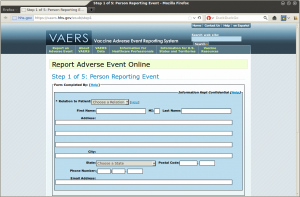Difference between revisions of "Vaccine Adverse Event Reporting System"
From Rx-wiki
(→Reporting) |
m (→See also) |
||
| Line 29: | Line 29: | ||
==See also== | ==See also== | ||
| − | [[MedWatch]]<br/> | + | [[Media:Vaers_form.pdf|VAERS form]]<br /> |
| − | [[ | + | [[Five rights]]<br /> |
| + | [[MedWatch]]<br /> | ||
| + | [[Drug recalls]]<br /> | ||
| + | [[Medication errors]]<br /> | ||
| + | [[Antidote]]<br /> | ||
| + | [[Tallman lettering]]<br /> | ||
| + | [[High-alert medications]]<br /> | ||
| + | [[Barcoding technologies]] | ||
==References== | ==References== | ||
Revision as of 07:00, 9 October 2012
The Vaccine Adverse Event Reporting System is a United States program for vaccine safety, co-managed by the Centers for Disease Control and Prevention (CDC) and the Food and Drug Administration (FDA). VAERS is a post-marketing safety surveillance program, collecting information about adverse events (possible side effects) that occur after administration of vaccines.
The National Childhood Vaccine Injury Act (NCVIA) of 1986 requires health professionals and vaccine manufacturers to report to the U.S. Department of Health and Human Services (HHS) specific adverse events that occur after the administration of routinely recommended vaccines. In response to NCVIA, CDC and FDA established VAERS in 1990
VAERS has demonstrated its public health importance by providing health scientists with signals about possible adverse events following immunization. In one instance, VAERS detected reports for intussusception over that what would be expected to occur by chance alone after the RotaShield rotavirus vaccine in 1999. Epidemiologic studies confirmed an increased risk, and these data contributed to the product's removal from the US market. In another example, VAERS determined that there may be a potential for a small increase in risk for Guillain-Barre' syndrome (GBS) after the meningococcal conjugate vaccine, Menactra. As a result of this finding, a history of GBS became a contraindication to the vaccine and further controlled studies are currently underway to research this issue.
Contents
Reporting
You are required to report all significant adverse events that occur after vaccination of adults and children, even if you are not sure whether the vaccine caused the adverse event. There are three ways to report to VAERS including online, by fax, and by mail. The online form can be found at https://vaers.hhs.gov/esub/step1 . You may also printout the VAERS form and fax it to (877) 721-0366 or mail it to VAERS, P.O. Box 1100, Rockville, MD 20849-1100. A pre-paid postage stamp is included on the back of the form.Number of Reports VAERS Receives
VAERS receives around 30,000 reports annually, with 13% classified as serious (e.g., associated with disability, hospitalization, life-threatening illness or death) (CDC VAERS Master Search Tool, April 2, 2008). Since 1990, VAERS has received over 200,000 reports, most of which describe mild side effects such as fever. Very rarely, people experience serious adverse events following immunization. By monitoring such events, VAERS helps to identify any important new safety concerns and thereby assists in ensuring that the benefits of vaccines continue to be far greater than the risks.
Many different types of adverse events occur after vaccination. About 85-90% of the reports describe mild adverse events such as fever, local reactions, and episodes of crying or mild irritability. The remaining reports reflect serious adverse events involving life-threatening conditions, hospitalization, permanent disability, or death, which may or may not have been caused by a vaccine.
Objectives of VAERS
The primary objectives of VAERS are to:
- Detect new, unusual, or rare vaccine adverse events (VAEs);
- Monitor increases in known adverse events;
- Identify potential patient risk factors for particular types of adverse events;
- Identify vaccine lots with increased numbers or types of reported adverse events; and
- Assess the safety of newly licensed vaccines.
Limitations
VAERS has several limitations, including unverified reports, underreporting, inconsistent data quality, and absence of an unvaccinated control group for comparisons to be made against.
See also
VAERS form
Five rights
MedWatch
Drug recalls
Medication errors
Antidote
Tallman lettering
High-alert medications
Barcoding technologies
References
- Wikipedia, Vaccine Adverse Event Reporting System, http://en.wikipedia.org/wiki/VAERS
- U.S. Department of Health and Human Services, About the VAERS Program, http://vaers.hhs.gov/index/about/index
- FDA, VAERS Overview, http://www.fda.gov/BiologicsBloodVaccines/SafetyAvailability/ReportaProblem/VaccineAdverseEvents/Overview/default.htm
- CDC, Vaccine Adverse Event Reporting System (VAERS), http://www.cdc.gov/vaccinesafety/Activities/vaers.html
- U.S. Department of Health and Human Services, Report an Adverse Event, http://vaers.hhs.gov/esub/index
